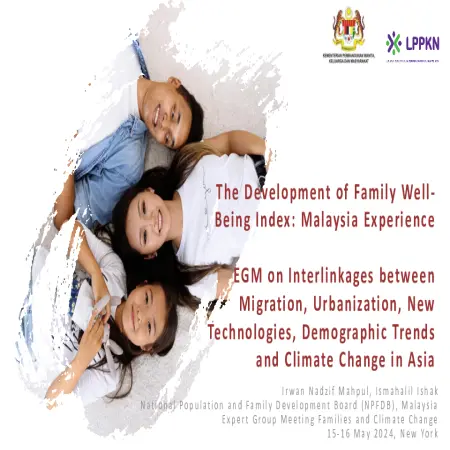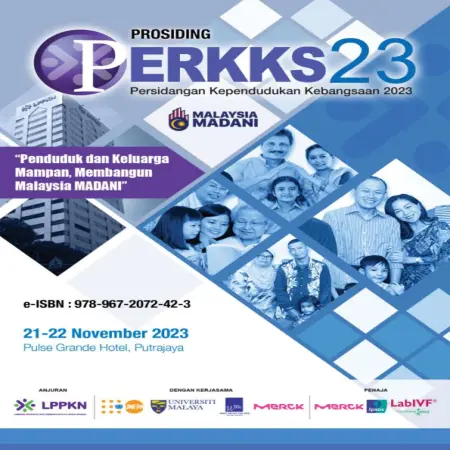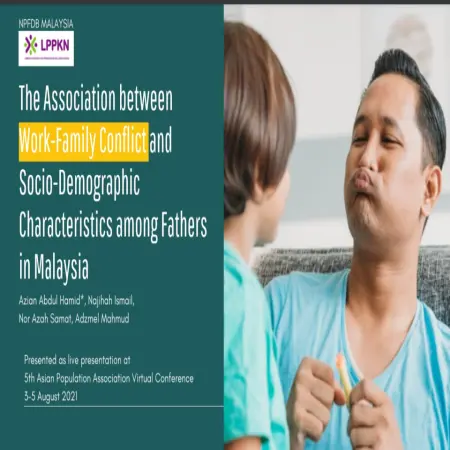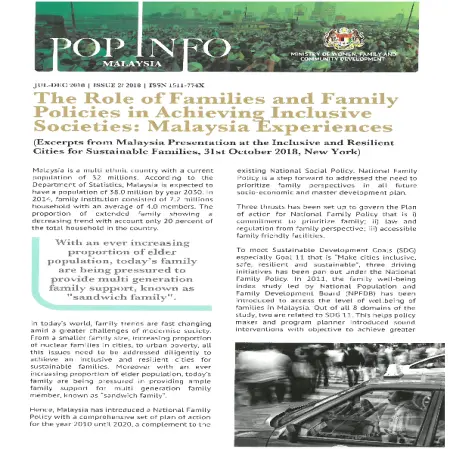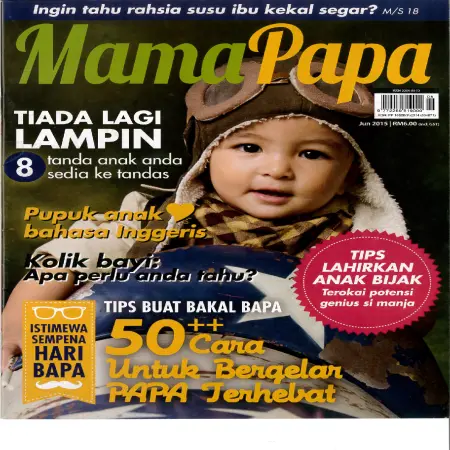TOPICS
Results for Topics : "Family"
|
|
The development of Family Well-Being Index: Malaysia experience. EGM on interlinkages between migration, urbanization, new technologies, demographic trends and climate change in Asia.
Item Type: Conference or Workshop Item
Editor:
Year: 00/05/2024
Abstract: The Malaysian Family Well-Being Index (MFWBI) was initiated in 2011 by the NPFDB with the aim to measure the levels of family well-being in the country and to recommend strategic initiatives to strengthen the implementation of future family intervention programs in Malaysia. In 2016, measurement of the MFWBI was repeated using an improvised instrument. The MFWBI 2016 had maintained all the 7 domain in the MFWBI 2011 and added one more domain, namely, Family and Communication Technology. The instrument’s refinement exercise was repeated again in 2019, and 2022 in order to measure the family well-being. The purpose of the refinement exercise was to ensure that the questionnaire was valid and relevant for current and near future use. The domain in the MFWBI are Family Relationship, Family Economy, Family Health, Family Safety, Family and Community Engagement, Role of Religion & Spiritual Practice, Housing and Environment, Family and Communication Technology. At the national level, the MFWBI has been recognized by the federal government as one of the national KPI in the country’s 5-year development planning (Eleventh Malaysia Plan, 2016 -2020 and Twelfth Malaysia Plan, 2012 – 2025).
|
|
|
|
|
|
The linkage of government assistance programs towards digital and financial well-being of small household income families in urban area during covid-19 pandemic
Item Type: Book Section
Editor:
Year: 00/12/2023
Abstract: The Covid-19 pandemic and the Movement Control Order (MCO) have had a negative impact on the financial well-being and digital well-being of B40 or small household income families in urban areas. In responding to the crisis, the government had launched multiple assistance programs to assist the group. Hence, the study intends to examine the relationship of government assistance towards digital and financial well-being of the group.
|
|
|
|
|
|
The 55th session of the Commission on Population and Development United Nations, New York, 25-29 April 2022
Item Type: Country Statement
Editor:
Year: 00/04/2022
Abstract: Malaysia’s socio-economic development has been significant in transforming our economy from a low income to an upper-middle-income status. We have achieved significant progress in eradicating poverty and narrowing inequalities. However, the COVID-19 crisis has resulted in vulnerable households falling into poverty and hardship.
|
|
|
|
|
|
The association between work family conflict and social demographic characteristics among fathers in Malaysia
Item Type: Conference or Workshop Item
Editor:
Year: 00/00/2021
Abstract: Those living in urban, Indian, age 30-44 years, higher educational level, single father, and non Muslim’s tend to face Work Family Conflict than their counterparts. More hectic/busy environment and higher cost of living in urban area compared to the rural area may contribute to the Work Family Conflict among fathers.
|
|
|
|
|
|
The Family Well-Being Index 2019
Item Type: Video
Editor:
Year: 00/00/2020
Abstract: A Short video on Family well-being index. The family well-being index (FWBI) is developed to measure the level of family well-being in the country. To continue monitoring the level of well-being of Malaysian families, the third series of FWBI was held in 2019 maintained all eight domains of FWBI 2016.
|
|
|
|
|
|
The role of the state in empowering family: Malaysia experience
Item Type: Newsletter
Editor:
Year: 00/00/2019
Abstract: Malaysia families today are facing numerous challenges related to changing of population and family structure as well as pressure of complex family responsibilities. The advent of modern lifestyle has witnessing the issues on adolescent sexual and reproductive health, changing attitudes towards marriage, work-life balance and intergenerational between elderly parents and young children. In view of the above trends and challenges, a National Family Policy will continue to be empowered.
|
|
|
|
|
|
The role of families and family policies in achieving inclusive societies: Malaysia experiences
Item Type: Newsletter
Editor:
Year: 00/00/2018
Abstract: With an ever increasing proportion of elder population, today’s family are being pressured to provide multi generation family support, known as “sandwich family”. Hence, Malaysia has introduced a National Family Policy with a comprehensive set of plan of action for the year 2010 until 2020, a complement to the family well-being index. Next, community based intervention program called Family and Community Empowerment Program (FACE) and Family Impact Assessment (FIA) where an evaluation on the impact of family-related policies and program will be accessed.
|
|
|
|
|
|
Toleh kiri dan toleh kanan
Item Type: Article
Editor:
Year: 00/06/2015
Abstract: The aspect of safety in the family needs to be educated and made a daily practice and needs to be educated with patience without despair. There are some simple tips to practice in family safety such as don’t stop praying, keep dangerous and important equipment in a special place, safe zone to explore and consensus brings blessings.
|
|
|
|
|
|
The prevalence of work-family conflict among mothers in Peninsular Malaysia
Item Type: Article
Editor:
Year: 00/11/2011
Abstract: Achieving work-family balance is dependent on managing the conflict between work and family roles. This study focuses on the prevalence of work-family conflict among mothers in Peninsular Malaysia. The objective of this study is to examine the relationship between perceived work-family conflict and socio-demographic and family characteristics of the mothers. Data were obtained from 801 currently working mothers (with at least having one child) who were between 15 and 49 years old in Peninsular Malaysia interviewed in the Fourth Malaysian Population and Family Survey (MPFS-4), 2004. The result of this study showed that ethnicity, age and employment are the main factors contributing to the prevalence of work-family conflict. However, there is no significant relationship between the prevalence of conflict and the studied family characteristics, namely, number of children, childcare arrangement and presence of children aged 7 to 24 years.
|
|
|
|
|
|
The 4th East Asia Ministerial Forum on Families, "safe and resilient families: protecting and empowering at-risk and high risk families", Kuala Lumpur, 7-10 November 2010
Item Type: Country Statement
Editor:
Year: 00/11/2010
Abstract: A family is a living, evolving institution, affected by socio-economic factors as well as by the changes that shape the social environment in which it functions. More often, the changes and transformations have brought both gains and losses to family institutions. Hence, the challenge today is to reinforce positive changes and secure those in the new environment, and at the same time, to mitigate the negative consequences of changes, without dampening the momentum for positive evolution.
|
|
|
|





